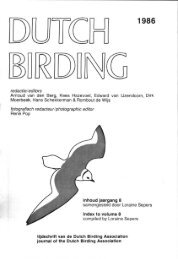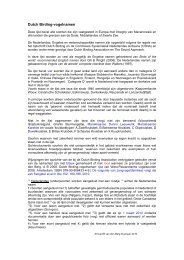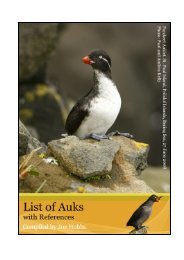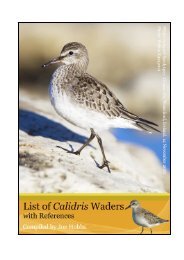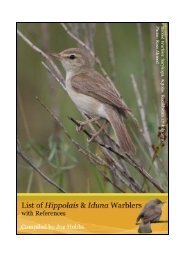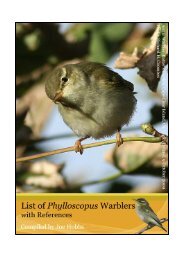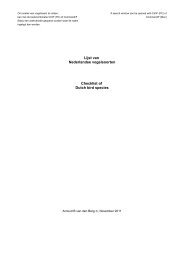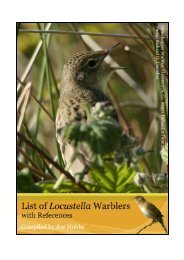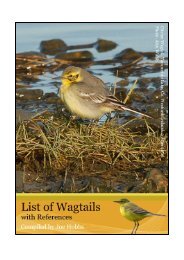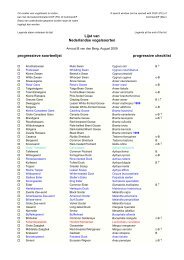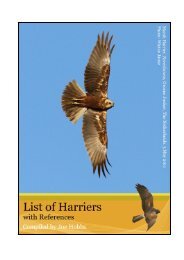1998-4 - Dutch Birding
1998-4 - Dutch Birding
1998-4 - Dutch Birding
You also want an ePaper? Increase the reach of your titles
YUMPU automatically turns print PDFs into web optimized ePapers that Google loves.
Striped Crake at Livorno, Jtd1y, in lanuary 199 7<br />
Marittimo del porto di Livorno) and by Valter<br />
Rinaldi . Daniele Marzi checked the files of [he<br />
seabird rehabilitation c :entre (CRUMA, Livorno) .<br />
Richard Bradbury and Michael Wilson ÍEdward<br />
Grey Institute, Oxford, England) made a numher<br />
of valuahle suggestions for changes to a draft of<br />
this no[e .<br />
References<br />
Arrit;oni Des;li C7ddi, E 1929 . Ornitologia ltalia na .<br />
dm ilan .<br />
Cramp, S& Simmuns, ií E L feditcrrs} 198{} . The hirds ot<br />
the Western Palearctic 2 . Oxforcl .<br />
Ripley, S D 1977 . Rails ot the world . Boston .<br />
Snow, D W & Perrins, C M (eclilorsi <strong>1998</strong> . The hirds of<br />
the Western Palearclic . Concise edition . OxÍord .<br />
del Hoyo, 1, Elliott, A& Sargatal, 1 Icxlilors) 1996 .<br />
Handbook of the hirds of the world 3 . Barcelona .<br />
Hudson, R 1974 . Allen's Galhnule in Britain and th e<br />
Palearctic . Br Birds 67 : 405-41 3 .<br />
Tiylor, B& van Perlo, B <strong>1998</strong> . Rails : a guide to the<br />
rails, crakes, gallinules and cools of the world .<br />
Mountfield .<br />
Urhan, E K, Fry, C H & Keith, S(editorsl 1986 . The<br />
hirds of Afric:a 2 . London .<br />
Adriano De Faverr, Istituto Nazionale per Ja Fauna Selvatica, via Ca Fornacetta 9,<br />
40064 Ozzano En 7ilia BU, Jtaly<br />
Nicola Baccetti, Jstituto Nazionale per !a Fauna Selvatic a , via Ca Fornacetta 9,<br />
40064 Ozzano Emilia BO, Italv<br />
En 7iliano Arcamone, COT, Museo di Storia Naturale, via KonTa 234 ,<br />
57100 Livorrlo L1, Jtaly<br />
Trends in systematic s<br />
Molecular study indicates sympatric<br />
breeding of Atlantic and Continental<br />
Great Cormorants in Britain<br />
In Europe . Great Cormorant Phalacrocurax carho<br />
is represented by two subspecies : Atlantic Great<br />
Cormorant P c carbo ihereafter carbo) which<br />
inh.i hits the coasts of Britain, France, Iceland and<br />
Norway, and Continental G reat C.ormorant P c<br />
sinensis ( hereafter sinensis), which breeds mainly<br />
in inland tree colonies in continental Europe . In<br />
the early 1960s, the north-western European<br />
population of sinensis was restricted to 800 pairs<br />
in two colonies in the Netherlands . In subsecluent<br />
decades . the population of sinensis in<br />
north-western Europe spectacularly increased to<br />
more than 60 000 pairs in 1993 (van Eerden &<br />
Gregersen 1995) . The increase coincided with a<br />
range expansion to other European countries .<br />
Until [he 1980s, inland nestin g of cormorants in<br />
Britain was sporadic but since 1981 the numher<br />
of inland breeding pairs has increased to more<br />
than 1100 in 1995 and breeding attempts have<br />
heen recorded at 35 sites (Goostrey et al <strong>1998</strong>) .<br />
Although inland breeding is commonly assoc:iatcd<br />
with sinensis, the ori gin and identity of these<br />
inland breeders has remained unce rtain ,<br />
Sellers ( 1993 ) attempted to determine the status<br />
of inland breeding cormorants at Abberton<br />
Reservoir, Essex, England, on the basis of three<br />
plumage characters, the shape of the gular pouch<br />
and ringing recoveries . Differences in morphology<br />
have been described and discussed on several<br />
occasions (eg, Stokoe 1958, Cramp &<br />
Simmons 1977, Alstr~m 1985) but assessing<br />
plumage and structural differenc :es in the field is<br />
not always easy and may be subject to age and<br />
seasonal variation . Gloss to body plumaF;e is<br />
greenish in sinensis and hluish or bluish-purple<br />
in carbo but the difference may be very difficult<br />
to determine in the field and its validity has been<br />
questioned (Marion 19951 . Both carbo and sinensis<br />
develop white head-feathers and white thigh<br />
patches at Ihe start of the breeding season . These<br />
feathers are at their hrit;htest and most extensive<br />
in the early phase of the breeding season and<br />
decrease in intensity as breeding proKresse.s<br />
(Sellers 1993 ). The exient of white feathers on<br />
the head is much greater in sinensis than in<br />
carbo but some carbo, mostl,v old males, may<br />
acquire heads as white as typical sinensis (Stokoe<br />
1958, Cramp & Simmons 1977, Alstrrim 1985) .<br />
Therefore, the presence or absence of white feathers<br />
is an inadequate basis for assigning lone<br />
birds to either carbo or sinensis. Aistrflm ( 1985 )<br />
emphasized a difference in the shape of the t;ular<br />
pouch; in sinensis the gular pouch exiends further<br />
back beyond the gape than it does in carbo<br />
(Alstr~m 1 985, Lewington et al 1991 } . Marion<br />
(1995) questioned the validitv of this criterio n<br />
174



